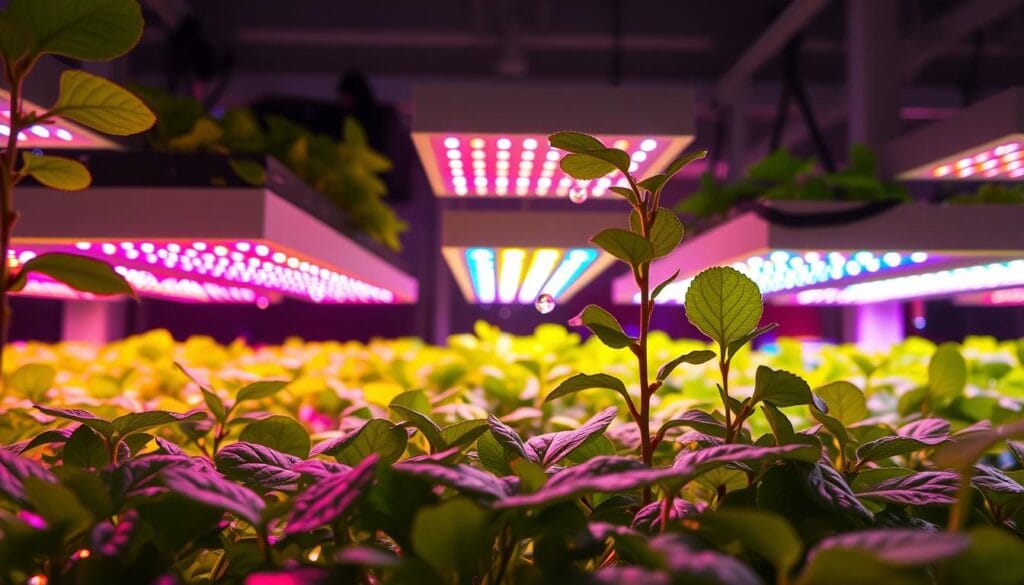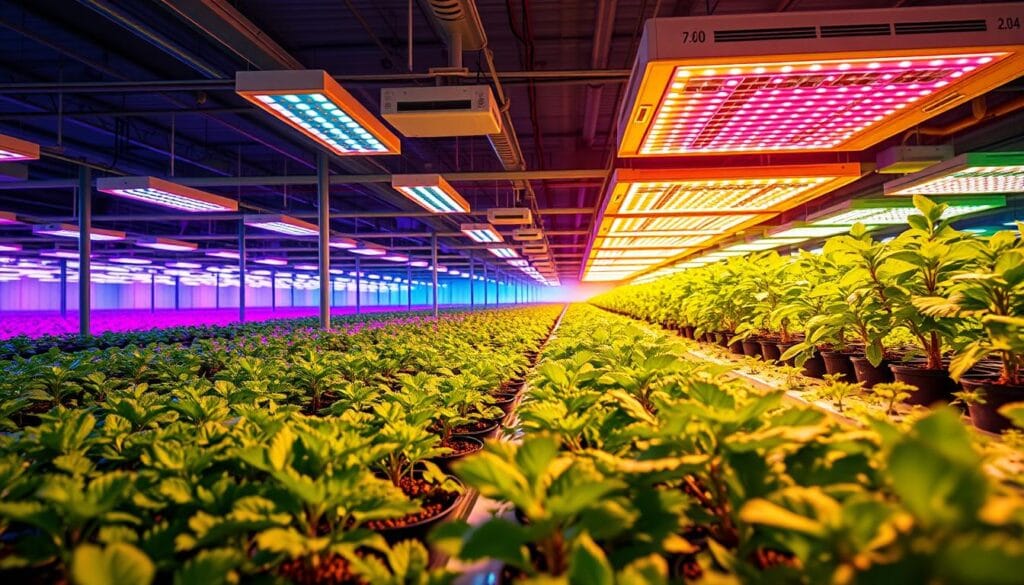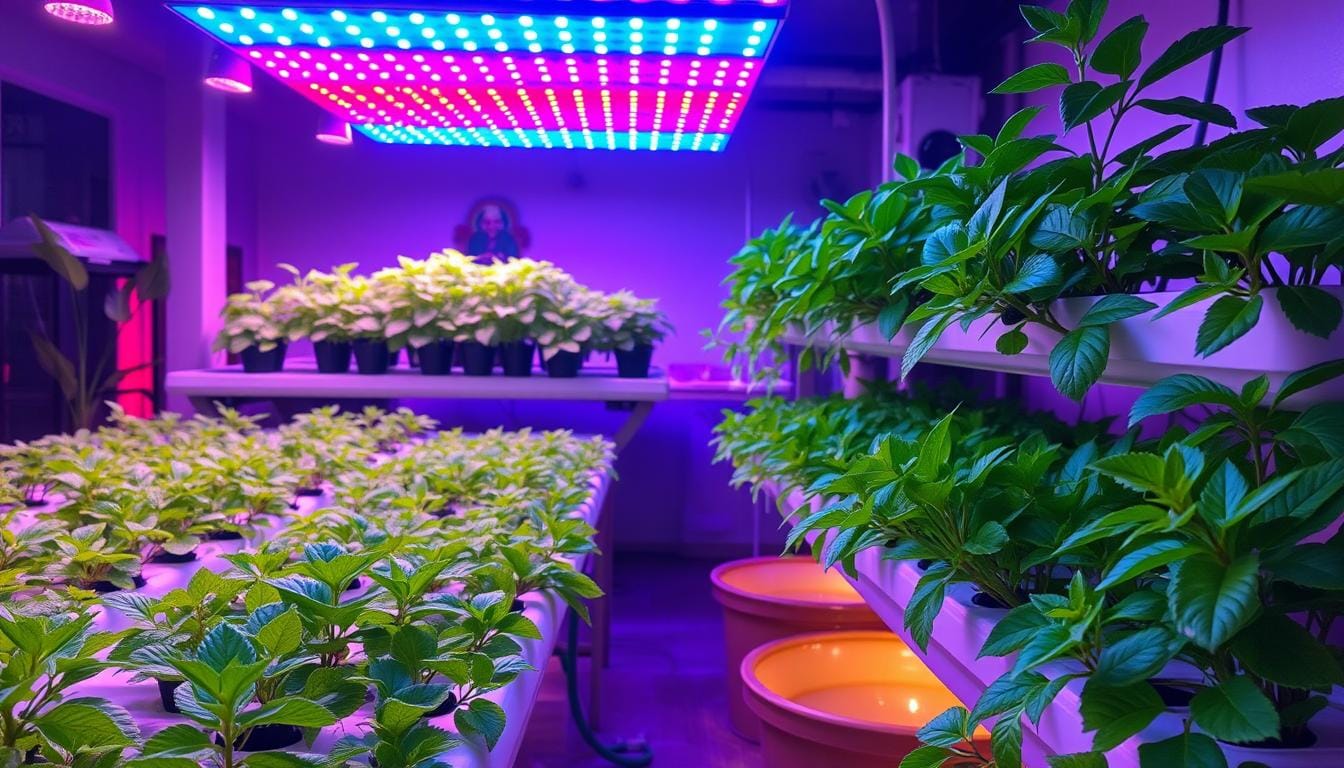I’ve seen how hydroponic systems and LED lighting change things. Growing up in the city, I never thought I’d grow food indoors. But now, thanks to indoor farming, it’s possible.
Hydroponics lets plants grow in water, not soil. LED lighting is key to making plants grow well. It gives plants the right light, helping each plant grow the best it can.
Key Takeaways
- LED lighting is vital for hydroponics, letting us grow food all year, no matter the weather.
- This tech is great for city farming, cutting down on food travel and keeping produce fresh longer.
- Eden Green Technologies uses hydroponic lighting in their vertical farms. This shows how it works in real farming.
- Hydroponics lets us control light, helping plants grow better.
- LED lighting is good for saving energy and money in indoor farming. It’s a smart choice for farming’s future.
Understanding Hydroponic Growing Systems
Hydroponic systems have changed farming, making it more efficient and green. They come in two main types: liquid and aggregate systems. Liquid systems, like
Deep water culture (DWC), don’t need a medium for roots. Aggregate systems, including nutrient film technique (NFT)
and aeroponics and wick systems, use a solid medium for plants.
These methods let farmers control the growing space well. They help solve problems like climate change and food shortages. Using treated wastewater for irrigation makes them even greener. With better eco-friendly illumination and modern lighting technology, hydroponic hydroponic systems are getting better at growing food.
| Hydroponic System | Description |
|---|---|
| Deep Water Culture (DWC) | Plants are suspended in a nutrient-rich solution, with their roots submerged in water. |
| Nutrient Film Technique (NFT) | A shallow stream of nutrient-rich water flows continuously over the plant roots. |
| Aeroponics | Plants are suspended in the air, and their roots are periodically misted with a nutrient-rich solution. |
| Wick System | Plants are grown in a growing medium, and a wick draws the nutrient solution from a reservoir to the roots. |
These new hydroponic ways have big benefits. They let farmers control the growing space better, grow more food, and use resources wisely. As people want more sustainable farming, hydroponic systems are becoming a top choice for farmers and gardeners.
“Hydroponics allows us to grow more food in less space, using fewer resources, and with a smaller environmental footprint.”
Fundamentals of Plant Light Requirements
Light is key for plant growth. It’s the main energy source for photosynthesis. Plants make glucose and oxygen from light, water, and carbon dioxide.
Each plant type needs different light levels. It is quantified using Photosynthetic Photon Flux Density (PPFD). More PPFD means brighter light. Knowing this helps your indoor garden grow well.
LED lighting is great for saving energy and providing bright and crisp illumination. But, pick the right spectrum and intensity for your plants. This way, your LED lighting can help your garden grow strong and produce lots.
| Light Requirement | PPFD Range (μmol/m²/s) | Plant Examples |
|---|---|---|
| Low Light | 50-150 | Pothos, Snake Plant, ZZ Plant |
| Medium Light | 150-400 | Philodendron, Monstera, Ficus |
| High Light | 400-800 | Succulents, Tomatoes, Peppers |
Knowing your plants’ light needs helps create the best growing space. This maximizes your LED lighting system’s benefits.
LED Lighting Technology in Modern Agriculture
LED grow lights are changing modern farming. They offer unmatched control and efficiency in indoor and vertical farming. These systems use LED chips to give plants the exact light they need. This helps growers improve growth and yield at every step.
Types of LED Grow Lights
LED grow lights come in many types, like the chip-on-board (COB) design. This design combines many LED chips into one for better light and evenness. Growers can adjust the light to fit their crops’ needs, from seedling to fruiting.
Color Spectrum Options
Controlling the color spectrum of LED grow lights is a big deal. Growers can now adjust the light for each plant stage. By changing the blue, red, and far-red light, they boost photosynthesis and growth.
Energy Efficiency Benefits
LED lighting is very energy-efficient. It gives the same light as old grow lights but uses less power. This saves money and is better for the environment, making energy-efficient lighting key in modern farming.
| Feature | Benefit |
|---|---|
| Precise Spectrum Control | Optimized plant growth and yield through tailored light environments |
| High Energy Efficiency | Significant cost savings and reduced environmental impact |
| Advanced Programmability | Automated light schedules and intensity adjustments for optimal plant development |
The use of LED lighting in farming shows how energy-efficient lighting and modern lighting technology change things. These systems give growers more control and efficiency. They are set to change indoor and vertical farming, making farming more sustainable and productive.
Photosynthesis and Light Energy Conversion
Photosynthesis is key for plants to turn light into energy in the form of glucose. This process is essential for plant growth and health. It gives plants the nutrients and oxygen they need to thrive. The quality and amount of light a plant gets affects how well it can photosynthesize, and LED lighting can help a lot.
Chlorophyll in plants absorbs blue and red light best. These colors are most effective for photosynthesis. LED lighting can be made to emit these colors, helping plants grow better and faster.
The process of photosynthesis includes two key phases: light-dependent and light-independent reactions. In the light-dependent phase, light energy is utilized to generate ATP and NADPH. These are then used in the light-independent reactions to make glucose from carbon dioxide. By improving the lighting conditions, you can make photosynthesis more efficient. This leads to more productive and energy-saving lighting for your hydroponic system.
“LED technology has transformed plant growth and development by enabling precise control over the light spectrum, intensity, and photoperiod.”
LED lighting in hydroponics lets you customize the light for your plants. By choosing the best wavelengths for photosynthesis, you can boost your system’s productivity. This makes your hydroponic system more efficient and effective.
| Wavelength Range | Effect on Plant Growth |
|---|---|
| Blue-violet and blue light (400-520 nm) | Drives photosynthesis and is crucial for leaf development |
| Green light (520-600 nm) | Absorbed by plants and contributes to overall plant growth |
| Red light (600-730 nm) | Essential for optimal photosynthesis and plant growth |
| Infrared light (starting at 730 nm) | Necessary for phytochrome transformation and plant development |
By picking the right LED lighting wavelengths, hydroponic growers can create a sustainable lighting solution. This solution maximizes photosynthesis efficiency and promotes healthy plant growth.

Optimal Light Intensity for Hydroponic Plants
For hydroponic plants to grow well, the right light intensity is key. This is quantified as Photosynthetic Photon Flux Density (PPFD), expressed in micromoles per square meter per second (μmol/m²/s).
PPFD Measurements and Standards
PPFD shows how much light plants can use. Different plants need different amounts of light. Some ornamental plants need as little as 20 μmol/m²/s. Others, like succulents, need up to 2000 μmol/m²/s.
Light Requirements by Plant Type
Knowing what light your plants need is crucial. Here’s a quick guide:
- Herbs and leafy greens do best with 150 to 250 μmol/m²/s.
- Fruiting plants like tomatoes and peppers need 600 to 800 μmol/m²/s.
- Flowers and ornamental plants prefer 300 to 600 μmol/m²/s.
- Succulents and cacti need the most light, from 500 to 2000 μmol/m²/s.
LED lighting in hydroponics lets growers control light levels. This energy-efficient lighting provides bright and crisp illumination. It helps plants grow well.
“Providing the right amount of light is crucial for the success of any hydroponic garden. By understanding and meeting the PPFD requirements of your plants, you can ensure their healthy growth and bountiful harvests.”
Photoperiods and Plant Growth Cycles
In hydroponic systems, LED lighting is key for plant growth. The light time, or photoperiod, greatly affects plant development. Growers use modern lighting technology to match light times to plant needs.
For example, a study showed that 14 hours of LED light exposure was best for hydroponic lettuce growth. Adjusting photoperiods helps in cannabis growing too. It lets growers keep plants in a growing state for more clones.
LED grow lights allow growers to create custom light plans for their crops. This use of sustainable lighting solutions boosts plant growth and yields. It enhances farming efficiency and boosts productivity.
“The utilization of LED lights can result in an increase in crop yields and a decrease in the time from sowing to harvest.”
LED lighting has changed modern farming in hydroponics. It lets growers control light and time for better crop growth. This leads to more productivity and a greener way of farming.
Impact of Light Wavelengths on Plant Development
Light wavelengths deeply affect plant growth in hydroponic systems. Understanding how light spectra influence plant biology helps growers optimize LED lighting. This ensures the best conditions for high-quality crops.
Blue Light Effects
Blue light, between 400 to 500 nanometers (nm), boosts vegetative growth and leaf development. It increases chlorophyll production, leading to lush foliage. Blue light also regulates plant circadian rhythms, aiding growth cycles.
Red Light Benefits
Red light, from 600 to 700 nm, is key for flowering and fruiting. It’s crucial for photosynthesis and helps distribute plant resources. This promotes blossom and edible development.
Full Spectrum Advantages
LED grow lights with a full spectrum, including blue, red, and green light (500-600 nm), support plants at all stages. This balanced approach boosts growth rates, yields, and nutritional quality.
Adjusting the light spectrum in energy-efficient LED lighting lets growers tailor conditions for different plants and growth stages. This can make hydroponic operations more efficient and sustainable.
“Different light wavelengths can dramatically impact the growth, development, and even the nutritional quality of hydroponic crops. By carefully controlling the light spectrum, growers can unlock the full potential of their plants.”
Temperature Management with LED Systems
LED grow lights are becoming more popular for hydroponic growing. They conserve energy and are environmentally friendly. LEDs don’t get as hot as other grow lights, making keeping the temperature right for plants easier.
LEDs can be placed closer to plants without harming them. This can help plants grow faster and stronger. LEDs also don’t let heat build up, which is bad for plants and the system.
- High-temperature LED lights are made to handle high heat, keeping them reliable and efficient.
- Good thermal management, like heat sinks and coolers, is key to stop LEDs from overheating and lasting longer.
- LED controllers help keep the temperature right, making sure LEDs work well and don’t get too hot.
LED lighting is becoming more common in hydroponics and indoor farming. Being able to manage temperature well is important for these systems to succeed. LEDs help create a better environment for plants, leading to better growth and saving energy.

“The reduced heat output of LEDs also allows for closer placement to plants without risk of heat damage, potentially increasing light intensity and improving plant growth.”
The industry will keep improving LED lighting and thermal management. This will make hydroponic systems even more efficient and green in the future.
LED Lighting vs Natural Sunlight
You can choose between LED lighting and natural sunlight for your indoor hydroponics setup. Sunlight is free and provides a complete spectrum of light. But, LED grow lights give you control over light intensity, spectrum, and duration. They let you grow plants indoors all year, no matter the weather.
LED lighting costs more upfront and uses more energy than sunlight. Yet, they can make plants grow faster and more consistently. Energy-efficient lighting like LEDs can also save you money on your utility bills over time.
Cost Comparison
LED grow lights cost more at first than sunlight, but they’re more sustainable lighting in the long run. Energy.gov says LEDs use 75% less energy and last 25 times longer than incandescent bulbs. This means big savings on your energy bills over the life of the LEDs.
Growth Rate Differences
Natural sunlight is free but can be unpredictable in quality and color. This can cause uneven plant growth. In contrast, LED grow lights let you control the light spectrum, intensity, and duration. This can lead to faster growth and more consistent yields for your hydroponic crops.
Choosing between LED lighting and natural sunlight depends on your location, crop, and goals. Weighing cost, control, and growth rate can help you pick the best lighting for your hydroponic system.
Setting Up LED Lighting for Hydroponics
Choosing the right LED grow lights is key for your hydroponic setup. LED lights are energy-efficient, last long, and offer a wide range of colors. Think about what your plants need, the size of your space, and how bright you want the light to be.
It’s important to place the LED lights right to ensure all plants get enough light. Keep them 12-18 inches above your plants for the best growth. Using a control system for light cycles and intensity can help your plants grow better and save energy.
Also, think about your growing area’s design when setting up LED lights. Using reflective materials can spread the light evenly. Make sure you have good air flow and temperature control to avoid overheating. With these considerations, you can make a great hydroponic setup using LED lighting technology.

